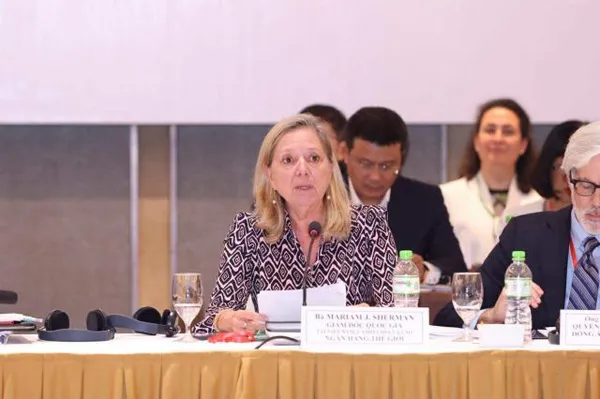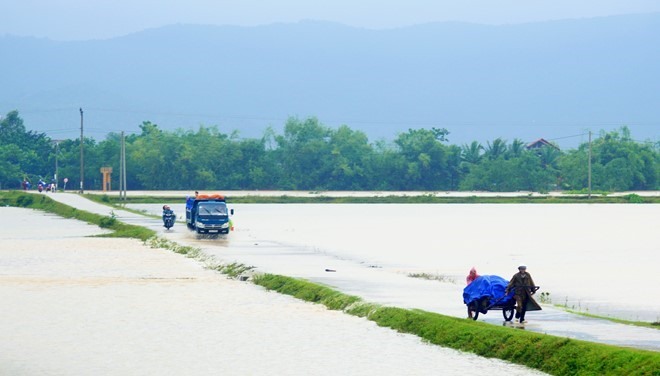 Op-Ed
Op-Ed

I did some research and found that the cow belonged to a farmer in Tuyên Hóa District, Quảng Bình Province. He said the flood waters rose to a three-metre high “too quickly” and swept the cow away as he was moving stuff in his house.
 |
by Thu Vân
They say you can see it in the eyes, but I had not really believed it till I saw it with my own eyes.
Amidst all the heart-wrenching images of people dealing with the devastating floods last week, one stood out and gripped me tight, and wouldn’t let go.
It was a cow, with only its eyes and nose above the water. Huge, dilated eyes, full of fear, suffering, and, yes, hope of survival.
I did some research and found that the cow belonged to a farmer in Tuyên Hóa District, Quảng Bình Province. He said the flood waters rose to a three-metre high “too quickly” and swept the cow away as he was moving stuff in his house.
However, he was able to grab it and tie it, with just its nose above the water. All the owner could do was pray that the water would not rise higher.
This story has a happy ending. The cow and the owner survived.
But the lives of 25 people were not spared as floods ravaged the central provinces. More than a 100,000 houses, 1,600ha of rice and over 3,000ha of fish farms went under. Around 500,000 people were displaced.
But don’t we hear this every year, without fail?
And it doesn’t get better, just gets worse.
The questions too, rise again and again in people’s minds. When disaster strikes with such regularity, why are more effective measures not taken to save lives and property, including cattle?
The befuddlement rises even higher when we consider the fact that Việt Nam has formally conducted post-disaster damage assessments for more than the last 25 years to quantify the losses of human life, property, infrastructure, production and other industrial activities.
Every year, Việt Nam spends hundreds of billions of đồng for flood relief. Every year, leaders hold meetings before and after the floods to direct preparations, relief operations and their assessments. Every year, preventive as well as responsive measures are identified to do better next time.
Despite all this, it seems that the more things change, the more they remain the same, which means people continue to suffer, year after year.
Typically, the blame for Việt Nam’s increased suffering from natural disasters is laid at the door of climate change.
But many experts have affirmed that the higher frequency and intensity of disasters, particularly flooding, has been primarily induced by human interference.
A 2011 report by the Ministry of Agriculture and Rural Development said 60 percent of the nation’s forest area has been destroyed for developing industrial zones and hydropower and irrigation projects.
This is surprising, because the fact that deforestation increases vulnerability to flooding had been realised much earlier. Ambitious afforestation policies and targets were announced, but they have not keep pace with activities that result in deforestation.
For instance, a five-year plan was launched in 2011 with the goal of rehabilitating more than 76,000ha of forests. As of 2014, just 7,191ha of deforested areas had been replanted in 28 of 55 provinces and cities. In 2014, some 12,000ha of forest land were lost to hydropower plants, but only 2,500ha were replanted.
Lê Huy Ngọ, former head of the Central Steering Committee for Flood Control and Prevention, used to say that “flood control and prevention” is a vague term. While flooding is natural, people can’t control or prevent it, but they can adapt to it. But when the flooding is manmade, several corrective measures are called for to protect the lives and properties of vulnerable residents.
There is no escaping the fact that the boom in hydropower development has increased flood risks considerably. Apart from the large-scale deforestation and attendant damage, improper design, construction and operation of dams can, and have worsened the situation.
On the night of October 14, water released from Hố Hô Hydropower Dam in Hà Tĩnh Province caused downstream water levels to rise at such a fast pace that no one could get a grip on the situation. Within 30 minutes, water levels rose from one to two meters high. Thousands of houses in the area were submerged. Around 27,000 houses in neighboring Quảng Bình Province to the south were also inundated.
In 2013, 15 hydropower reservoirs in the central region discharged their waters after heavy rainfall, killing 46 people and flooding 425,000.
What happened then happened again, this year. The management of hydropower plants claimed they had informed people of the discharge, but local officials said the notice was too short.
The management also defended their action, saying if they hadn’t discharged the water at that time, there was a significant risk of a dam breach, which would inflict far greater damage.
After hearing reports from the dam officials, Đỗ Đức Quân, head of the Hydroelectricity Division of the General Department of Energy, said the discharge of water that night was a “reasonable” action. He agreed that the consequences would have been much worse if the dam were breached.
Pause. Did I read that right?
I have to disagree. The collateral damage argument does not work.
When dams are built, the project documents do not just talk about power production. They claim the high ground, saying it would control river flows, protecting residents from floods and providing water during the dry season.
What is happening on the ground, however, contradicts these claims. The power plant companies seem to discharge water during the floods, and reserve water during the dry season, leaving the residents high and dry during all seasons.
Phạm Hồng Giang, chairman of the Association of Large Dams and Water Resources Development, admitted that due to the lack of co-operation and lax management of hydropower plants, a majority of small and medium hydropower projects do not comply with integrated water resources management principles.
I am not sure that large dams are applying these principles very efficiently, either, but I think it is high time a comprehensive review is done of all hydropower projects in the country to adjust or even terminate the operations of those that put people’s lives at risk.
A “pragmatic” approach that accepts the repetition of manmade disasters is untenable, and the Government should take the tough action to prevent such manmade disasters.
In this case, the TINA (There-Is-No-Alternative) argument is simply NA (Not Acceptable). — VNS




